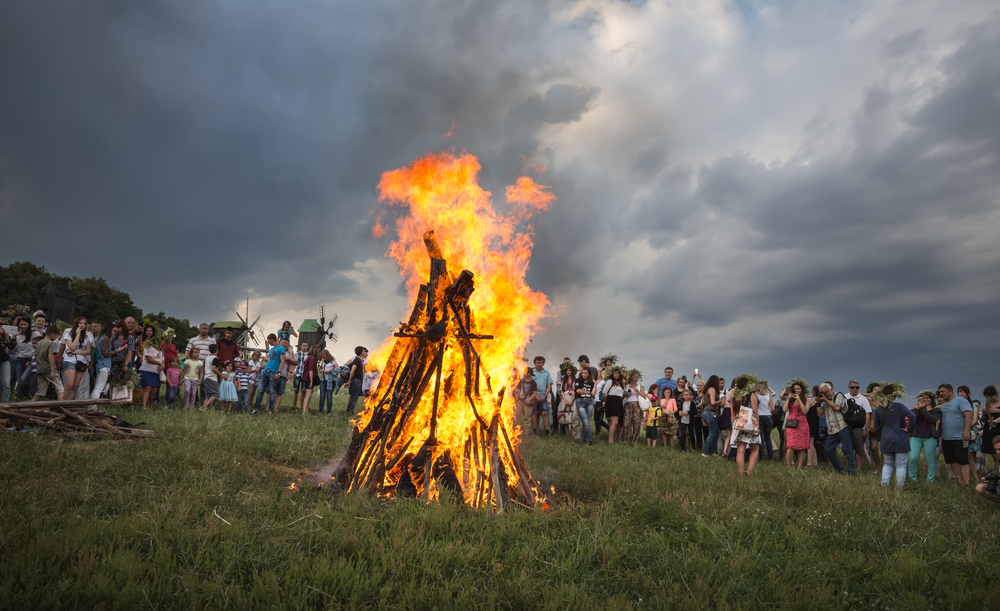Religion: Folk and Traditional Religions
Paganism
Introduction: Paganism is an ancient religious tradition that dates back to pre-Christian times. It was practiced throughout France until the Christianization of the country between the second and fourth centuries CE. Nature is sacred and divine to pagans, and a major belief is that life has a natural order to which humans are tied. Many pagans are polytheistic, believing in multiple gods and goddesses that are linked to or represent elements of nature.
Origin: Paganism's roots trace to thousands of years ago, long before the arrival of Christianity in France. Ancient France was occupied by many groups, including Gauls—Celtic people of western Europe—as well as Romans and Normans. Pagan practices vary though many events and celebrations were tied to the seasonal cycles of nature.
History: Paganism flourished in pre-Christian times, as agricultural communities were closely tied to nature. As the country became Christianized, pagan practices declined in popularity and were eventually suppressed, wth practitioners increasingly persecuted.
Adherents: There are no official statistics on the number of adherents to paganism, though historically it was the dominant belief system pre-dating Christianity.
Belief System: Paganism is inextricably linked to nature, its divine status, and the cycles of the season, including astronomical events. Paganism is most often a polytheistic religion—worshipping an assortment of gods and goddesses who represent nature or natural phenomena. Reincarnation is a traditional pagan belief. Some pagans practice magic, sometimes simply in the form of creating potions thought to help in attaining a need, like healing or protection.
Practices: Pagans practice a variety of rituals and ceremonies, including offerings to gods and goddesses, celebrating the changing of the seasons, or the cycles of the moon and sun. Many ceremonies and rituals related to planting, harvesting, and hunting. Recognizing ancestors is another common practice, with some pagans paying tribute to them at home alters.
Rituals, Events, Celebrations
- Festivals and holy days: These occur throughout the year, many of which are tied to the cycles of the seasons and the agricultural calendar.
- May Day: This day is a celebration of the end of winter and includes dancing, bonfires, and fertility rituals. Dancing around a "May pole" is traditional, with the pole representing males and the ribbons symbolizing females.
- Midsummer: Celebrated on the summer solstice, this day recognizes fertility and of light defeating darkness. Large bonfires are lit to ward off dark forces, thought to be strong during the longest day of the year.
- Yule: Celebrated on the winter solstice, (usually around December 21), this is a time for celebrating the return of the sun. Celebrations include feasting, singing, dancing, and music, and marks the beginning of the new year.
Sacred Texts: Pagans do not have a specific sacred text, but draw upon a variety of sources, including ancient myths and legends, poetry, and folk tales.
Places of Worship: Forest clearings and lakesides were common places for pagan worship. Some pagans have ancestor altars in their homes. For pagans who also practice or incorporate aspects of major religions like Christianity, churches are places of worship.
Sacred Places: French pagans revered mountain peaks, caves, springs, and wells as sacred places.
Leadership Structure: Paganism does not have a formal leadership structure, but rituals or celebrations may be led by elders or spiritual guides.
Role in Society: Paganism has experienced a resurgence as a way for many French to connect with their ancient heritage and culture. It is seen as a way to preserve traditional practices and beliefs that are specific to French culture and identity.
Animism
Introduction: Animism is the belief that all things, living and non-living, have a spirit and that these spirits must be respected and appeased to ensure good health, prosperity, and protection. Animist beliefs in France are often linked to pagan practices, which sees nature as divine and the living as part of nature's cycle. Polytheists recognize multiple gods and goddesses, most linked to or representing elements of nature.
Origin: Animism has been practiced in France since ancient times and predates the arrival of Christianity in the region.
History: Animism has a long history, with different ethnic groups developing their own variations of practicing the belief. Its practices predate the rise of Christianity in France, which occurred during the third and fourth centuries.
Adherents: Animism is practiced throughout the country including among indigenous ethnic groups. Exact numbers are difficult to estimate, as many practice animism alongside or as a part of other religions. Pagans and animists often have overlapping beliefs, as nature is a central feature, is seen as divine, and is often represented or embodied in various gods and goddesses.
Belief System: Animism is based on the belief that all things, including animals, plants, rocks, and even inanimate objects, have a spirit. These spirits can be benevolent or malevolent, and must be appeased through rituals and offerings to ensure good health, prosperity, and protection.
Practices: Animism is practiced through a combination of public and private rituals. Public rituals, such as ceremonies to honor the spirits of ancestors, are often held in sacred groves or open-air shrines. Private rituals, such as offerings made at home altars, are performed by individuals or families.
Rituals, Events, Celebrations
- Ancestor veneration: The spirits of ancestors are believed to influence living affairs, and gifts of food and drink were given to them including at home alters, grave sites, or sacred places with aims of receiving blessings or protection.
- Seasonal events: The changing of seasons held importance to animists, as agricultural communities were tied to planting and harvest seasons. Solstices were important as well, often recognized with bonfires, singing, and dancing.
- Nature worship: Many rituals involve asking for blessings and protection from "beings" such as rivers, lakes, and mountains.
Sacred Texts: Animism does not have a central sacred text but relies on oral tradition to pass on knowledge and traditions.
Places of Worship: Animism does not have specific places of worship, but considers certain natural features, such as trees, groves, streams, and rocks, as sacred.
Sacred Places: Many natural features in France are considered sacred in animism, including mountains, rivers and lakesides, and forests. These places are believed to be inhabited by spirits and are often the site of ceremonies and offerings.
Leadership Structure: Animism does not have a centralized leadership structure, but rather relies on local community leaders and traditional healers.
Leaders (local) and Dates: Local leaders of animism include traditional healers and community elders.
Role in Society: Historically, animism, often tied to paganism, played an important role in French society. Some of its practices and beliefs have seen a revival in modern times, particularly through a renewed reverence for nature and aims to live in harmony with it. Some cultural practices and events have animistic roots, tying French culture to its history and mythology.
Copyright © 1993—2024 World Trade Press. All rights reserved.

 France
France 
